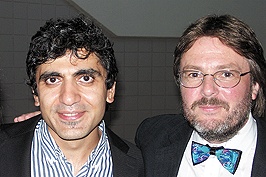Sebouh Krioghlian
Staff Writer

On a Sunday afternoon, September 10, 2006, Vardan Mamikonian, a prize-winning pianist, performed in the Fresno State Concert Hall to a sold-out crowd. This opening concert of the Philip Lorenz Memorial Keyboard Concerts series was co-sponsored by the Armenian Studies Program. Mamikonian’s performance was moving, to say the least.
Born in Yerevan, Armenia, Mamikonian started studying music early, at the age of six, at the Yerevan School of Music. He then moved on to studying at the Moscow Conservatory and later to the prominent Tchaikovsky Conservatory, where he became the pupil of Valery Kastelsky. Following this, he studied with Lazar Berman, and received First Prize at the Balis Dvarionas Piano Competition in Vilnius in 1981. He soon received many other first prizes and recorded works by Ravel, Tchaikovsky, Babajanian, Stravinsky, and Khatchaturian for Solistice Records; Chopin’s Etudes Op. 10 and Op. 25 and waltzes by Ravel, Liszt, Chopin, Scriabin for the Callipe label; and works by Bach and concerti by Rachmaninoff, Liszt, and Mendelssohn for Orfeo label.
Vardan Mamikonian began his performance with music by Armenian composers, from Komitas to Babajanian, which comprised the more unique part of the recital. “Danse Ounabi,” by Komitas, started off the event with a melodically simple, yet somewhat disturbing ambiance. This was followed by “Danse Vagharchabad” originally by Komitas and arranged by Babajanian, which strongly contrasted with the first piece, being much more complex, and fairly upbeat. This piece was definitely one of the more recognizable pieces to those who are familiar with classical Armenian music. He followed this with Babajanian’s “Danse Folklorique,” “Choral,” and “Poème” to conclude the Armenian portion of the concert. In general, these pieces seemed to be very atmosphere oriented, with parts that were reminiscent of the scores of horror movies. At other times the pieces were more emotional and some parts were even playful. The pieces performed seamlessly blended the Armenian influenced melodies with an emotionally rich cascade of melodies and Mamikonian’s style accented the many emotions without having to over-emphasize the dynamics.
He followed these pieces with works by Chopin’s No.3 and No.4 from Mazurkas, Op.33; Polonaise in Fsharp Minor, Op.44; and Waltz in A-Flat Major, Op.42. Some of these pieces were played with so much power that Mamikonian often led the listener to forgetting that there is only a solo pianist. At other times, there was great restraint, with more importance being given to control and clarity. Overall, the last pieces chosen for the first half led to a very dramatic close.
After intermission came Debussy’s “La plus que Lente” played very elegantly, followed by Ravel’s “Valses nobles et sentimentales.” His performance ended with “Valse Oublièe” and “Spanish Rhapsody,” which really showed his technical mastery of the piano as well as the emotions he was able to bring with them. After much applause he chose to play Babajanian’s “Elegy” as an encore piece, which returned to the Armenian theme that started the concert. Overall, the pieces played were very atmospheric, providing the score to an emotional film whose visuals were left up to the listener to imagine.
 Hye Sharzhoom Armenian Action
Hye Sharzhoom Armenian Action